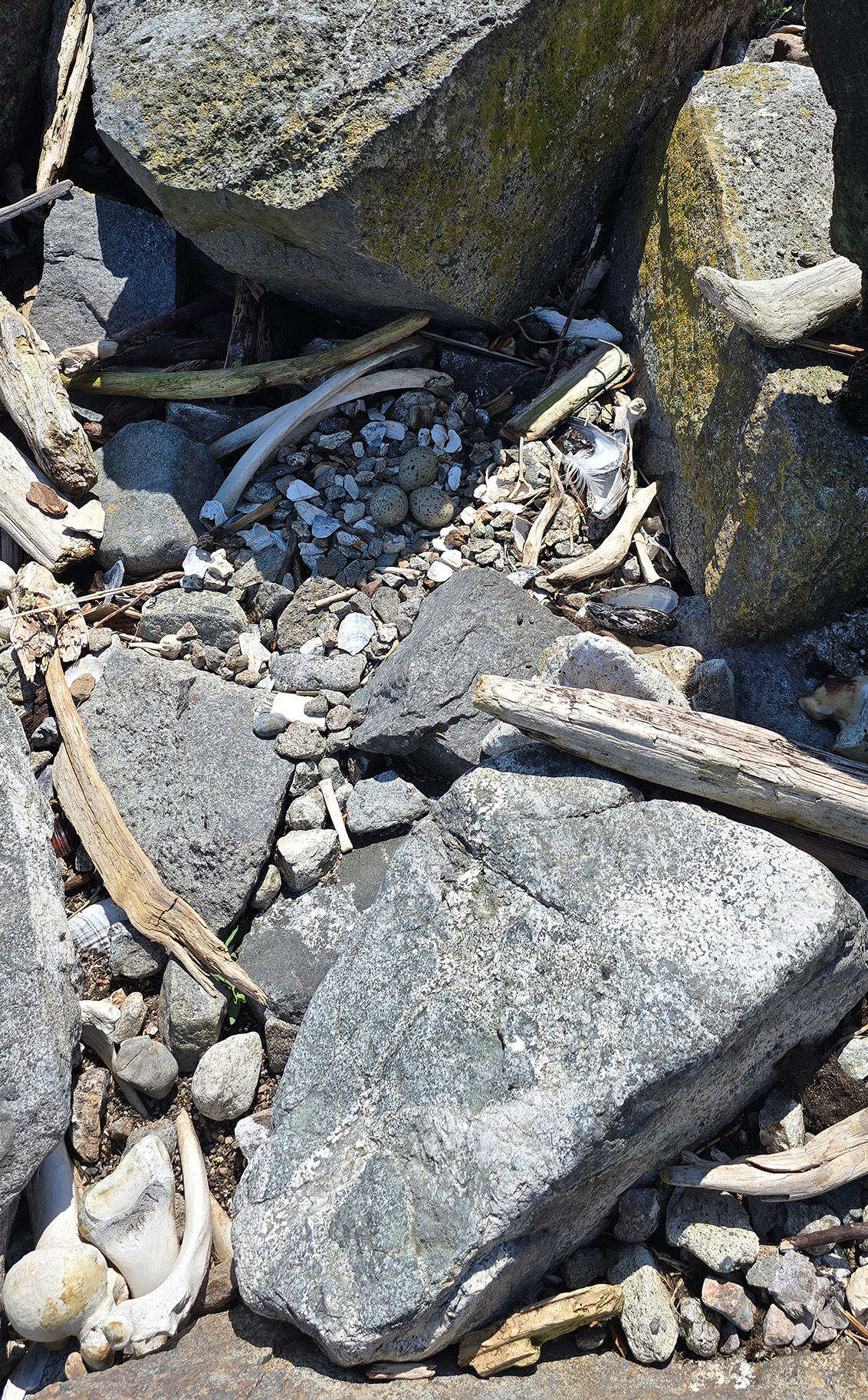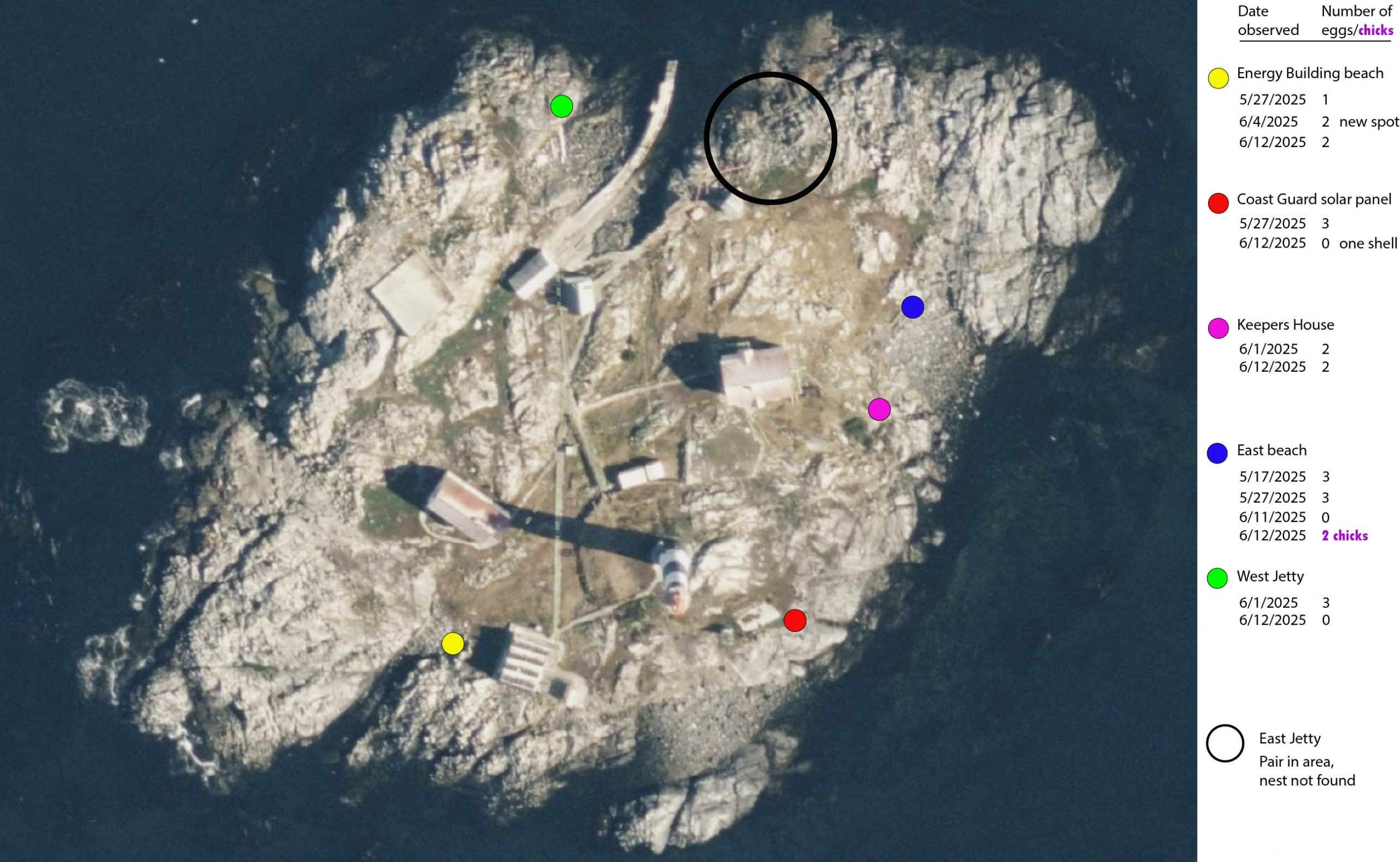I spent last night and most of today cursing the @#$* gulls after I found the East Beach oystercatcher nest empty yesterday. Seeing all the gull egg shells strewn about I figured they had taken the oystercatcher eggs as well. Today I visited the other nests on the island:
- East beach – empty, 5/27/2025 3 eggs
- West Jetty – empty, 6/1/2025, 3 eggs
- Coast Guard nest – empty, 5/27/2025 3 eggs
- Keeper’ House – 2 eggs, as previously observed
- Energy Building – 2 eggs, as previously observed
I found it interesting that they still occupied the area and called when I approached. This is in contrast to the gulls on the walkway that lost their last egg to predation, who just vacated. It took about 24 hours before it occurred to me that they may have hatched. I researched incubation period and reviewed when I first observed an oystercatcher chick last summer – it was June 12th 2024! I ran out and sat for a while with the binoculars watching the East Beach parents. What joy! Two chicks were scrambling about.
Tomorrow is census day so I will spend some time sitting still and watching the other empty nests. It may be more challenging as the West Jetty and the Coast Guard nests are not on a beach but several meters above the shore and it is possible they took their chicks to down to the shore line.
In today’s reading I discovered this amazing Haida story explaining their pale feet and bright beak ( I used to picture them as old, heavily lip sticked ladies in panty hose):
“When Xaw’s North Wind son brought the daughter of Xyuu Southeaster to live at his father’s house, she found it covered in icicles. These were her father-in-law’s fingers. When she inadvertently broke some, Xaw grew angry and trapped his daughter-in-law in ice and snow while she searched the shore for skats’aguu limpets. After some time she called her father from the south, singing continually for his help. Then the wind blew from Gangxid Kun, the southern-most point of Gangxid Gwaay.yaay Kunghit Island. The ice trapping Xyuu’s daughter melted. Then Xyuu himself arrived attended by black clouds full of rain and Xaw’s icicles fell.
Today sgaada.nga black oystercatcher skitters along the coasts of Haida Gwaii on crooked legs, still white and bent from the cold Xaw brought upon her for breaking his fingers. She pokes the shore with her long nose, reddened with Xaw’s frost. Their distinctive, long legs never carry them far from shorelines where they forage.” (See source)
Some of what I learned today (For more fun facts see source 1, 2)
- they are monogamous, loyal long term mates
- the incubation period averages 27 days, both sexes incubate
- their eggs are hardy enough to withstand occasional cold water submersion
- estimates of population size 10,000 pairs from the Aleutian Islands to Baja California – at least 5 of these are here on this tiny rock
I also learned too much about their incubation and sex roles in Prince William Sound, Alaska (See source)
- they attend their nest for 96% of the day
- nest failure due to predation by mammals or flooding (there are gulls there)
- females spend 20% longer on the nests because they aren’t as disturbance-motivated as the males
- duration of disturbance ending incubation period is 56-73 minutes and duration of incubation period ending for duty relief is 94-110 minutes
- the night time incubation bouts are longer, which could be due to prevalence of nocturnal predators or the lower temperatures at night
Facility work
- cleaned the solar panels
- started cleaning in the tank shed
Vessels
- Ecotourism: 4
- Private: 1
Weather
Fresh westerly breeze most of the day, winds increasing to WNW 30 knots by early evening. Daytime temperatures: low 11, high 14.



